September for me is always about memories of how fine the weather seemed to be when I was back in school in St. Mary’s in Clonmel looking wistfully out the window to glorious sunshine , distant memories I know but always halcyon days !
I love September in the garden , cool temperatures and balmy evenings , the grass mowing is reduced and now planning for next season … not serious planning more musing however where our front garden was concerned serious action was about to be taken as Peter Cullen was back on the scene available for work and there was a pond to be either repaired or a radical new design installed .
Colour in the September garden


Did I mention a radical redesign of the front garden pond ?
The front pond was one of the first garden projects we undertook back in April 2006 with Peter and it’s butyl rubber lining gave no trouble until May 2023 when I tried to have it cleaned and in the process the lining was punctured half way up the side and the height of the water dropped to less than a third … two decisions had to be made either replace the liner entirely , a messy job where the entire pond area had to be removed to fit the new liner or remove the entire pond and start with a new design .
To be honest I had never been entirely happy with the pond all these years , too concrety and it always looked artificial although the plant life was great with terrific water lilies but it never gelled with me … so a straightforward renewing was not an option and this left the way forward for a complete revamped new design .
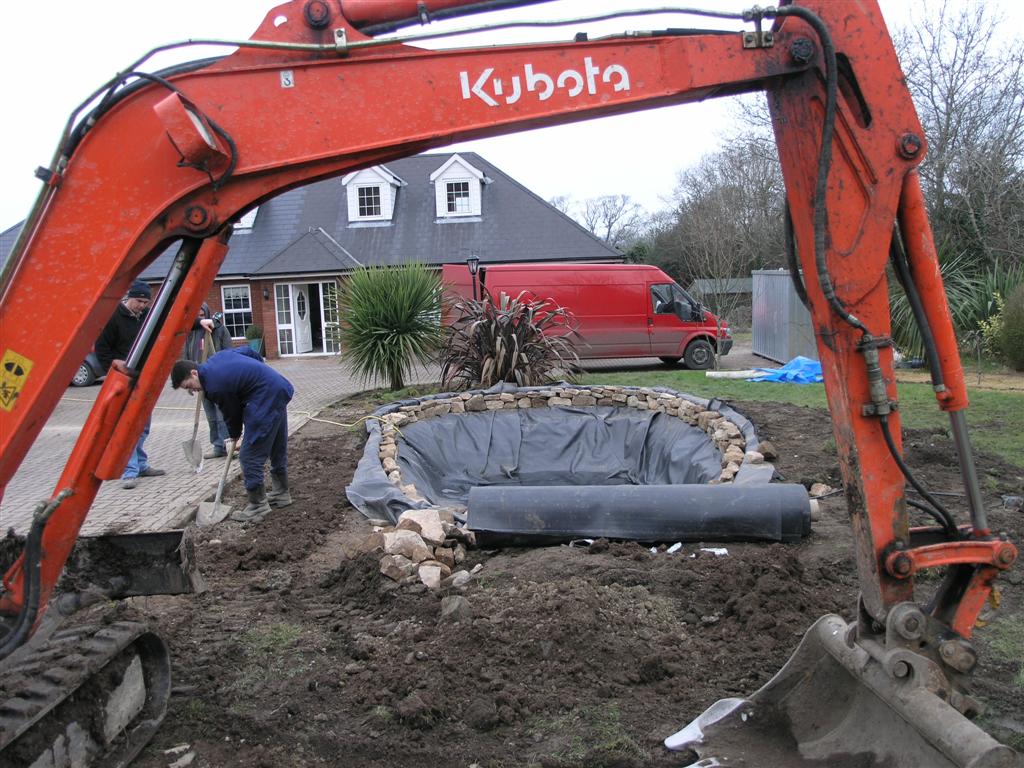
Snezana and I tossed ideas back and forth and Peter arrived to build whatever design we went for which initially right up to the night before construction was to start , was for a large patio area with a smallish formal rectangular pond in the middle … then came a Eureka moment where all the stars aligned and for the first time Snezana and I actually agreed on a garden design !
We decided we had enough water in the garden already so wouldn’t include a pond at all instead we would use the entire area for a large patio and then Peter’s expertise as a constructor and garden designer kicked in … Peter set out a plan that instead of a large unbroken patio he would build a small entrance of paving slabs with a planting area on both sides … Snezana and I picked out an Indian limestone slab with Manor Stone in Rathdowney , Co. Laos but decided not to have a planting area instead we picked a medium size burgundy stone chippng to fill in the planting area on both sides of the entrance which we would then use to position garden pots as an inviting entrance to the new seating are .
Finally having agreed the plan Peter moved in with a small mini digger and filled in the pond which gave us an idea of the eventual size available and over a coffee looking at the cleared site the three of us agreed that a more radical approach was needed which would mean removal of several trees and all of the surrounding shrubbery and perennial plants to open up the area surrounding the new patio… tough decision and heart breaking to see fifteen year old clumps of crocosima and rodgersia being dug up but a brutal approach was needed to get the new design and I was able to save a good amount of plants for transfer over the winter to other areas of the garden .
Demolishing the old pond
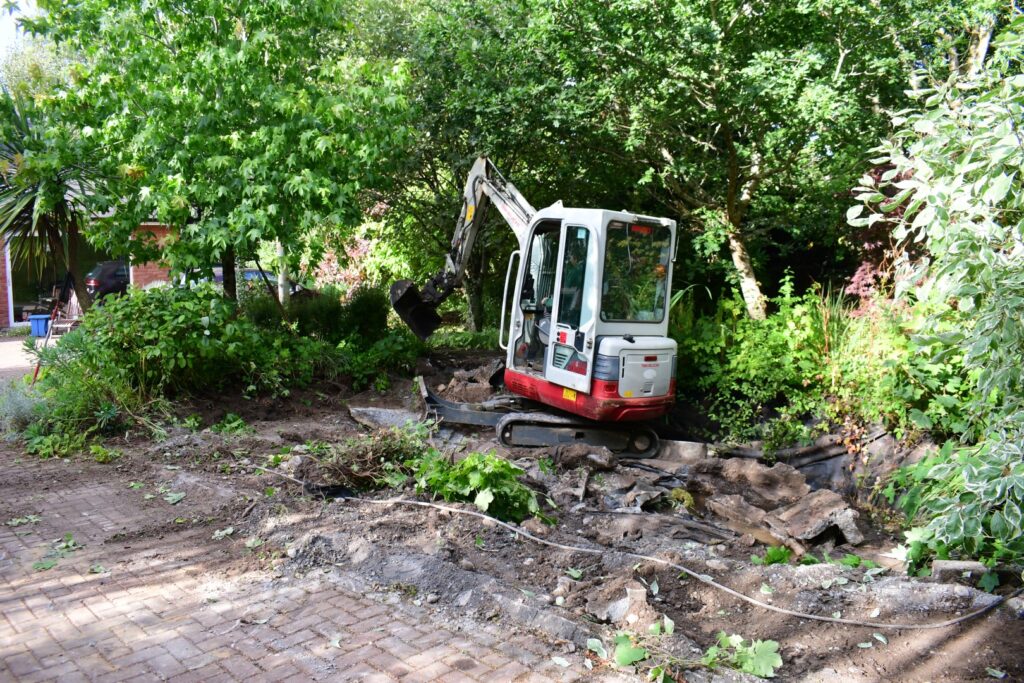
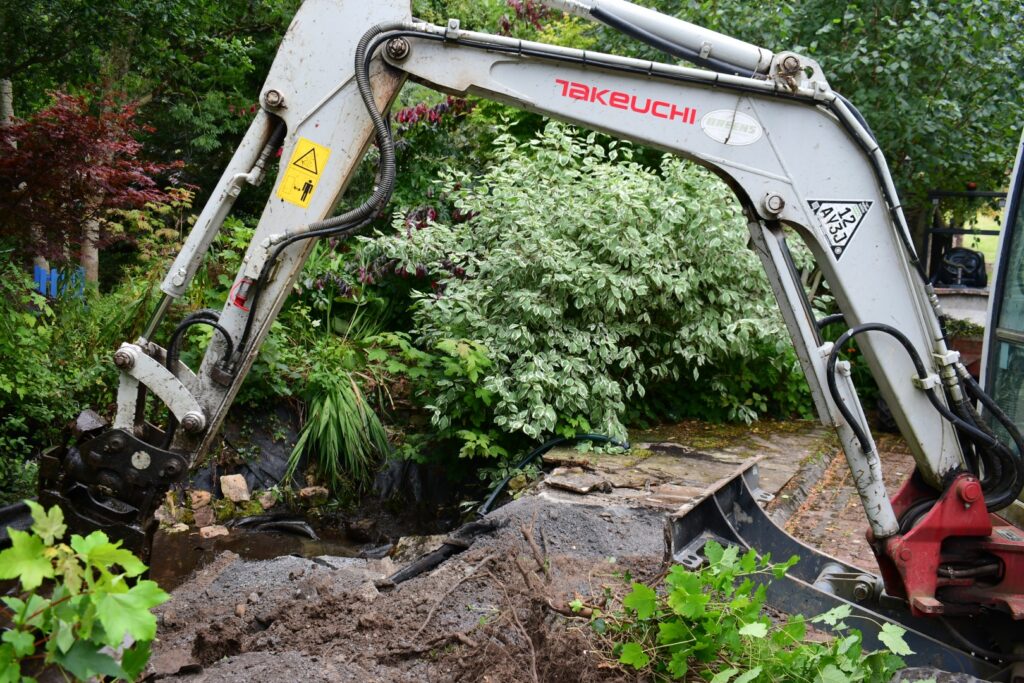
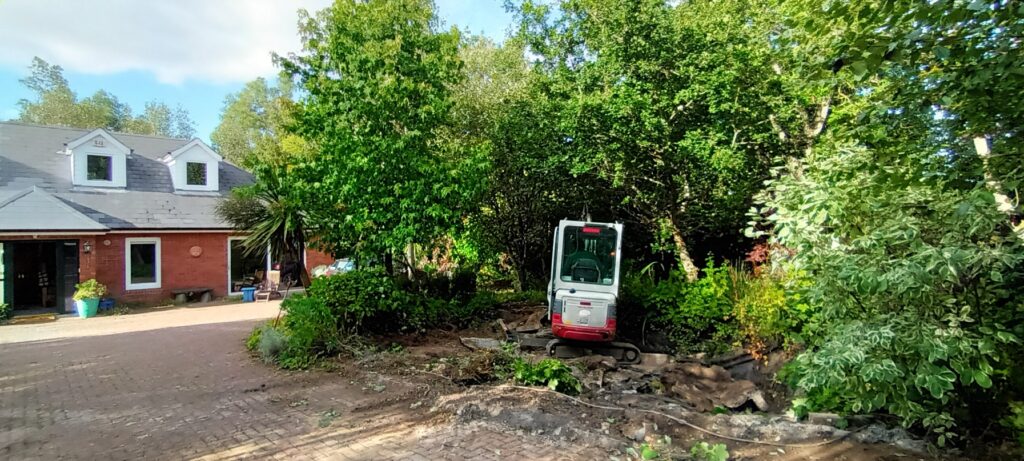
The beauty about working with Peter is that nothing is too much trouble for him and just whisper that maybe that tree should go and ten minutes with the digger and it is gone !
The old pool is filled in and the site prepared for the new patio area


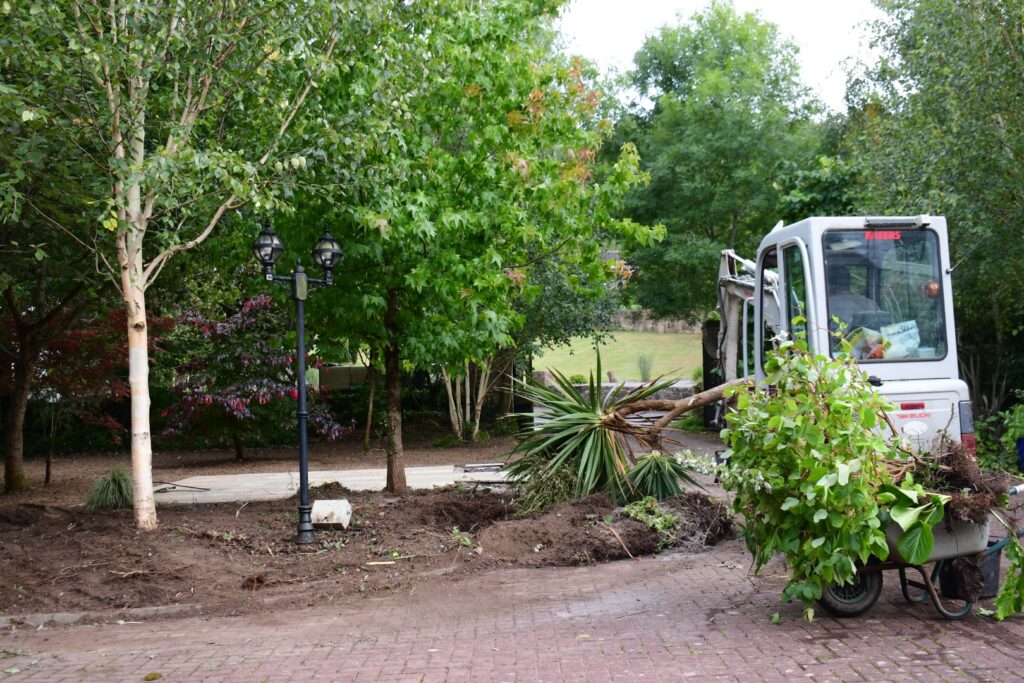
Little did we think back in 2006 when we were trying to get planting going in the front garden that it would grow so well and that eighteen years later we would go back to a basic minimalist look and we were lucky that five key trees did so well , a silver birch , an acer , a liquidamber , a persicaria ( persian ironwood )and a self seeded oak and they are now the back bone of that area of the front garden .
I recycled nine pots from other parts of the garden and after a lot of huffing and puffings with various lay outs they also found their place in the new scheme .
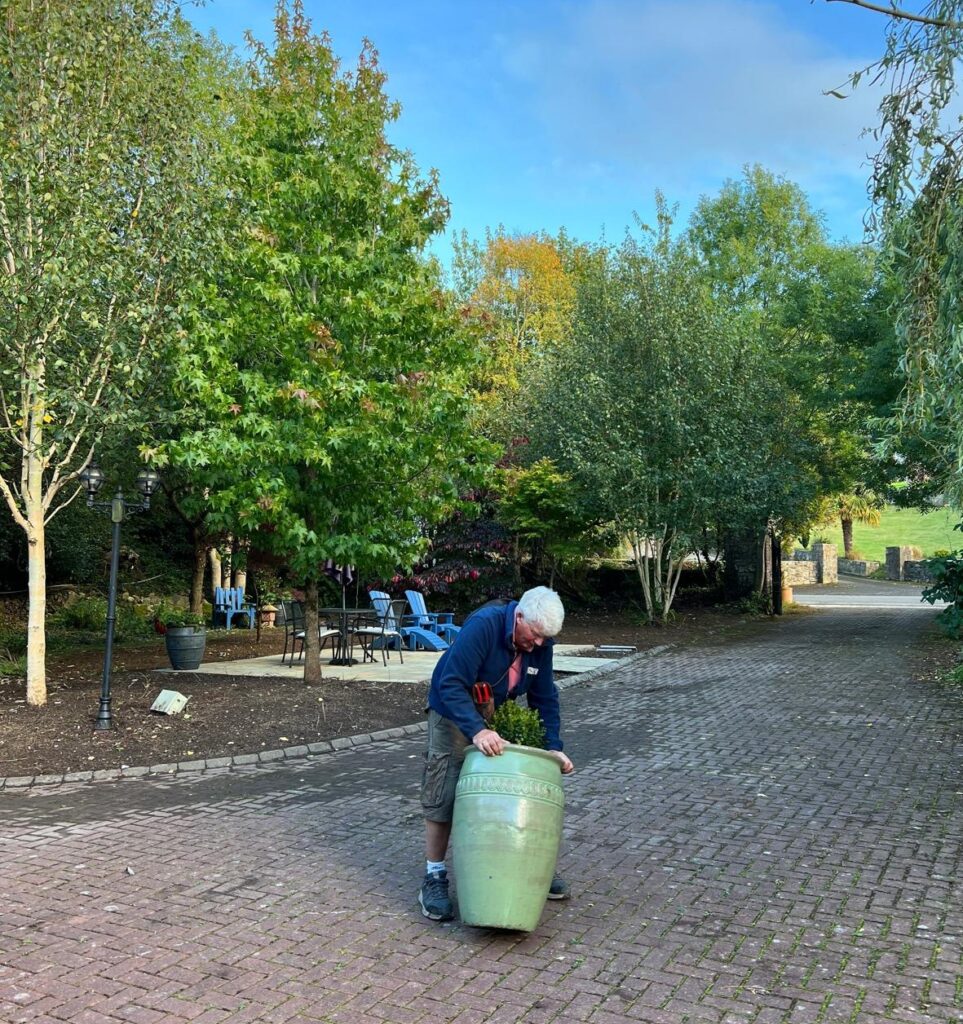
The new front garden now looks bigger with less clutter of plants and we are delighted with it .
The finished patio, Front Garden
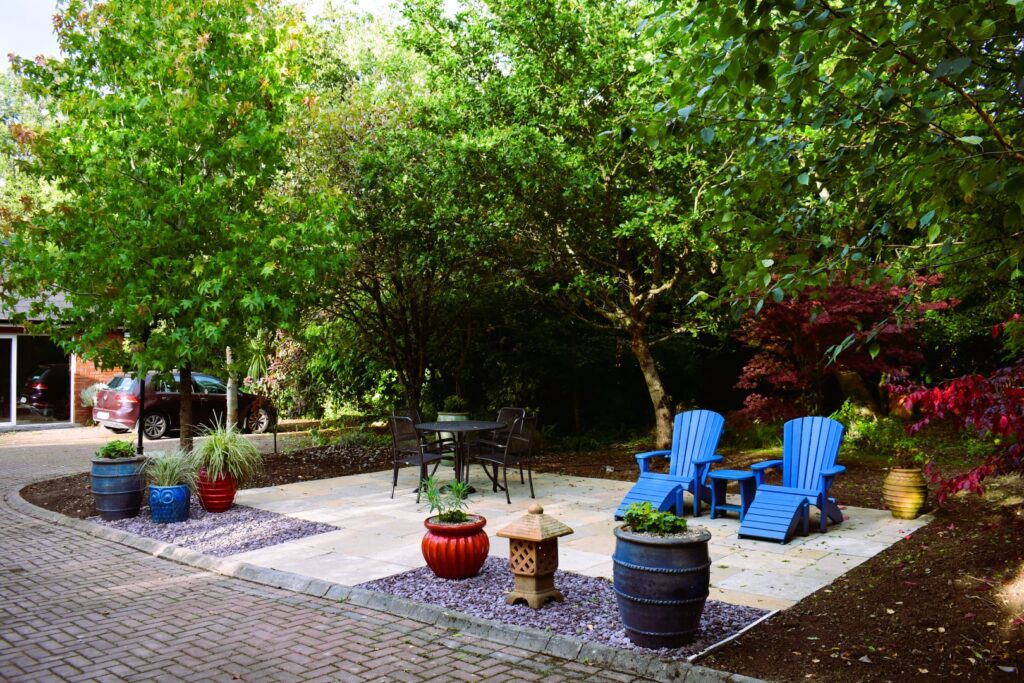
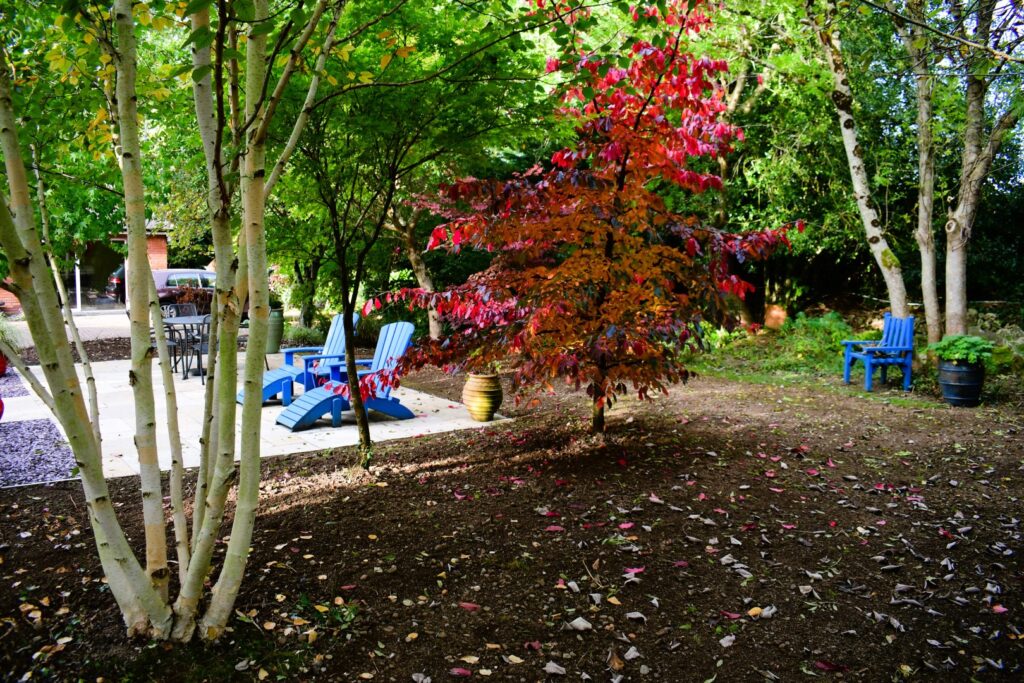
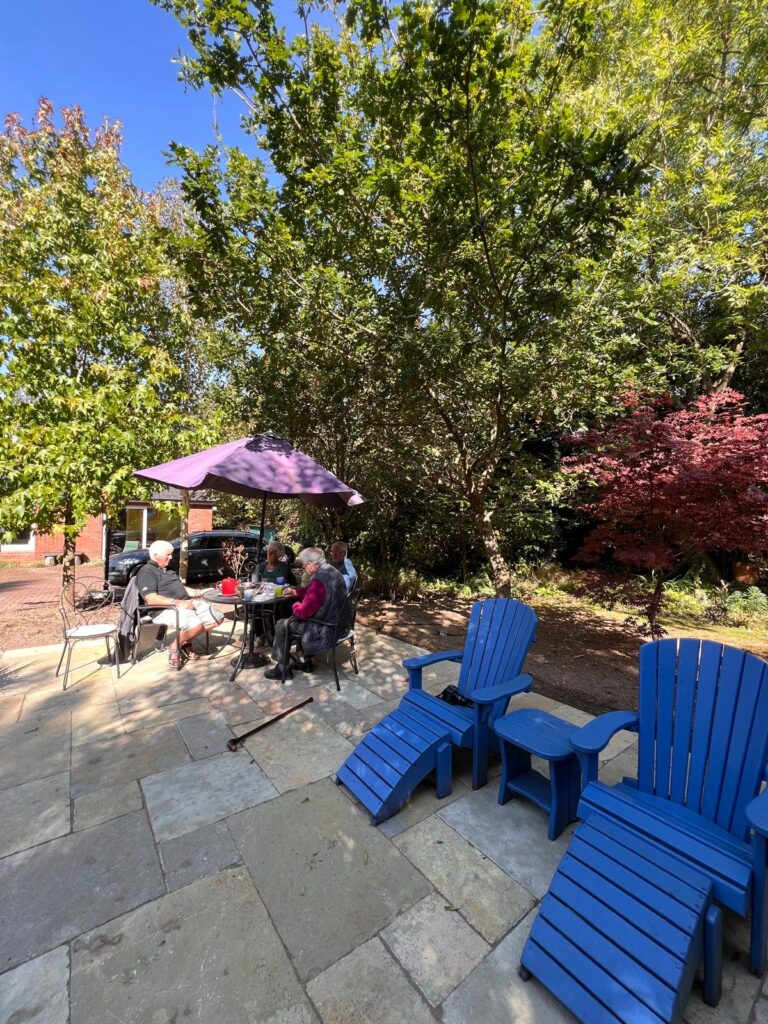
Peter Cullen when he is available always transforms any of our garden project with minimal fuss and I feel this is his masterpiece with us after an eighteen years collaboration .
A shrub that is underrated is rosememary and I am a big fan of the creeping form or prostrate but two things you need to know are give it plenty of room especially if planting beside a path and the second is to keep removing the under side of the shrub as rosemary like lavender will grow away on top but underneath will be dead wood which if you ignore it as I regularly have done it will just take away the lovely shape of creeping rosemary and just become bulky .
This month I finally had to tackle seven year old rosemary that I had planted both too close to the edge of the path with the result that it was blocking half the path in an already small space in the Croatian garden in Gornja Podgora and the shrub no longer looked prostrate and just closed off the garden.
How the rosemary had grown over the path

I started by removing four large barrels of top growth and while this was an improvement the overall shrub looked exposed and rubbishy to be honest and I decided to go full Snezana mode and dig out the entire five shrubs … this actually opened up the garden and once removed I hardly missed them at all .
The new more open look without the rosemary
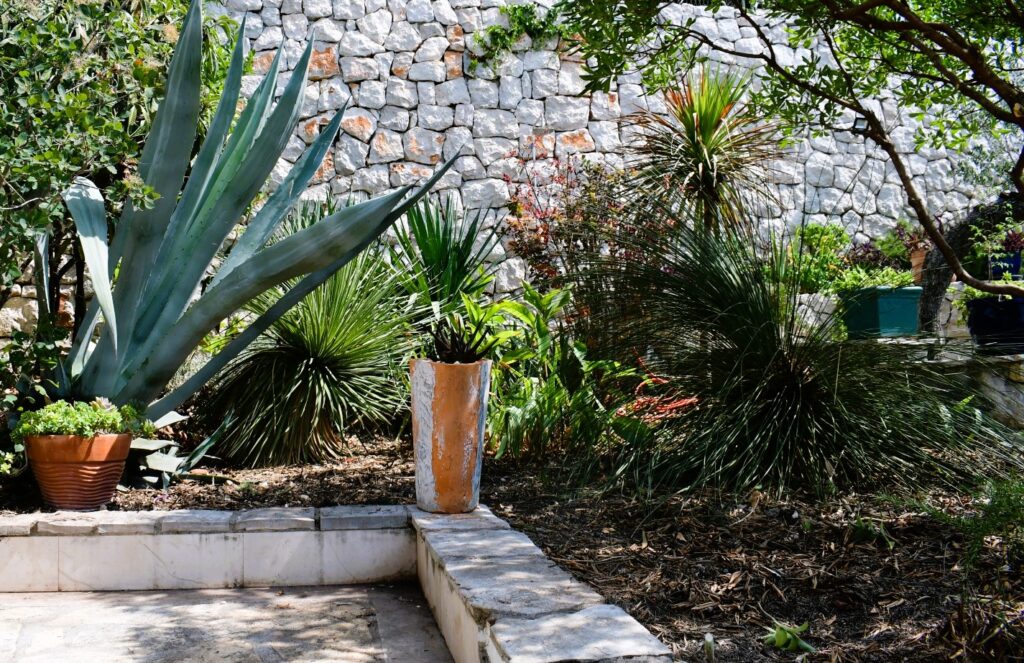
Of course having exposed quite a bit of ground round the old rosemary and it looked very nice , however the old saying nature abhors a vacuum is particularly true in an Adriatic / Mediterranean garden where weeds and wild flowers spread almost overnight … so how to fill the vacuum . The area is burnt by the sun throughout the summer months so the plants needed to be pretty drought and sun resistant and a further consideration was that having removed the rosemary on the basis it had just got too big and out of hand , the new plants needed to be low growing … I have a lot of aloe vera given to me by Mate Srdic from Makarska and these over the years have thrived and self seeded without any drop of water or hands on care from me and have self seeded into paths where I don’t really want them but up to now hadn’t the heart to move … now the aloe vera have been transferred to the new area underplanted with gravel and some aloe I was able to tease off baby aloe ( seven off shoots from one aloe ) and hopefully over the winter they will establish themselves .
Return to Sarajevo and Mostar in September
We travelled into Bosnia with good friends from Gornja Podgora , Julie and Ico Marinovic stopping in Jablanica for it’s famous dish of lamb barbequed on a spit … mainly for Ico who is Croatian and Snezana from Macedonia while Julie and I who are more refined stuck primly to the salads !
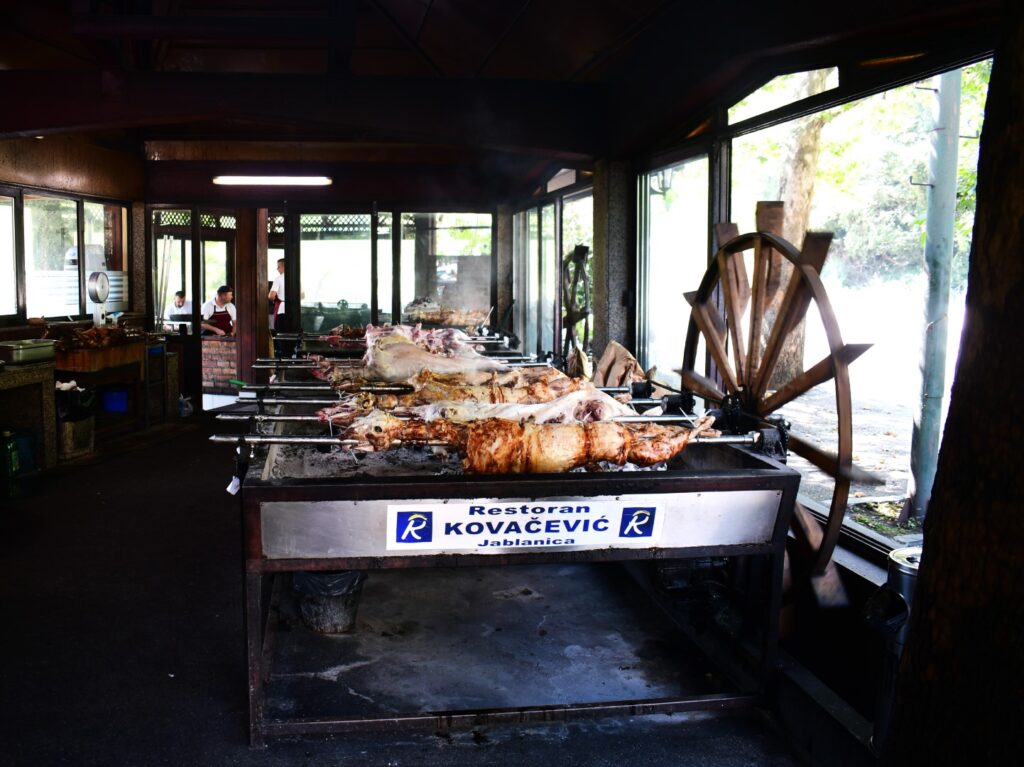
Going back is different as a tourist than when I worked in both Sarajevo and Mostar as I always seemed to be either in meetings or travelling to meetings , always busy with no time to relax and enjoy the atmosphere of two unique and different cities . Sarajevo was always a multi ethnic international city from the Ottoman times , an important cosmopolitan air about it whereas Mostar is more homely strung out along both banks of the Neretva river where the East side is Muslim and the West Bank is Croat and since the 1993 Bosnian War a deeply divided city and never the twain shall meet …so bad is the political will to cooperate in Mostar that after a national election it can take up to three years almost to the next election to elect a governing body .
The famous centre of Sarajevo is the Old City district of Bacarsja while Mostar is centred on the Stari Most or Old Bridge , the famous Ottoman bridge built in the mid 1400 ‘s .
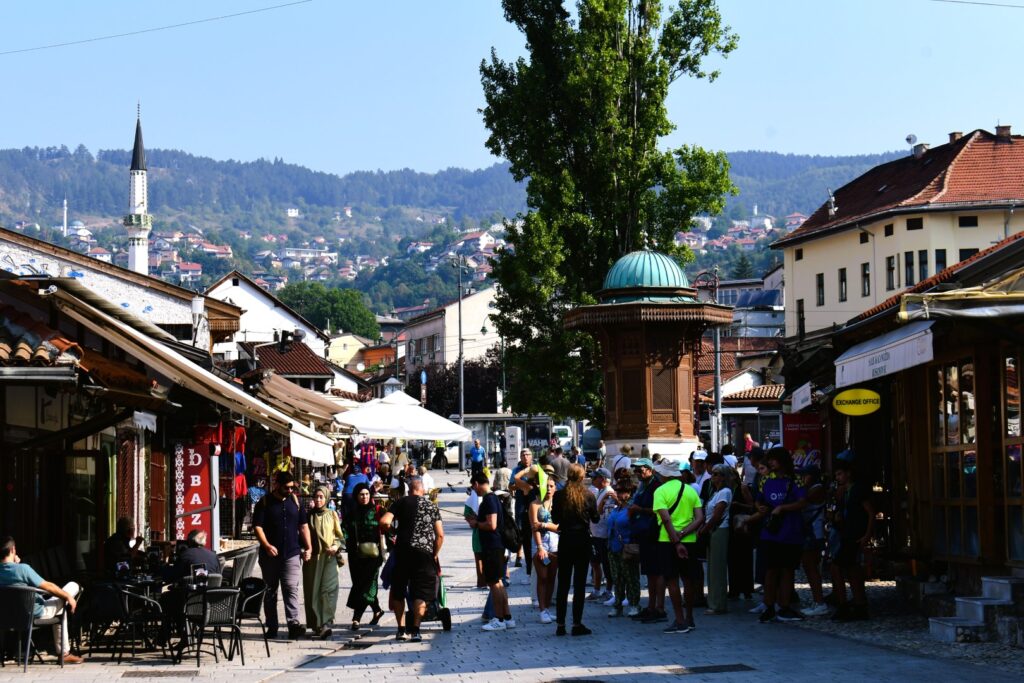
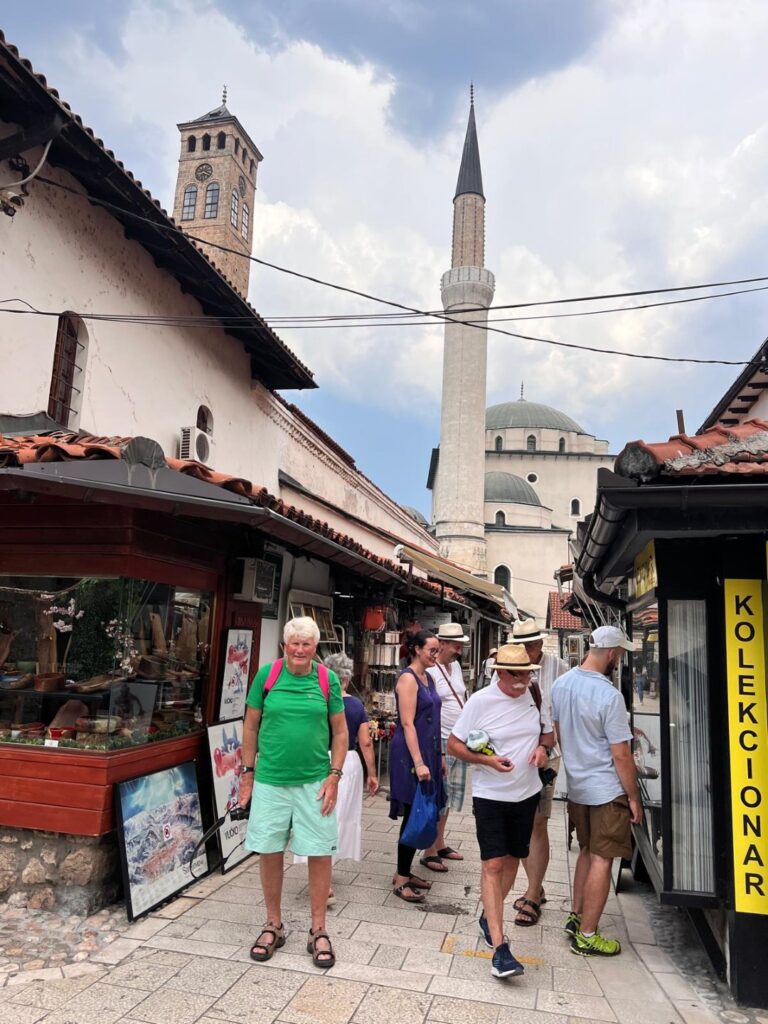

We were first in both cities three weeks after the Bosnian War ended in early 1996 , grim times with most buildings either destroyed or in a bad way while in Mostar with one of the last shots of the war Croatian military took down the old bridge into the river … accepted now by all as a cultural crime if not cultural genocide but at the time misguided nationalism had made hearts grow cold .
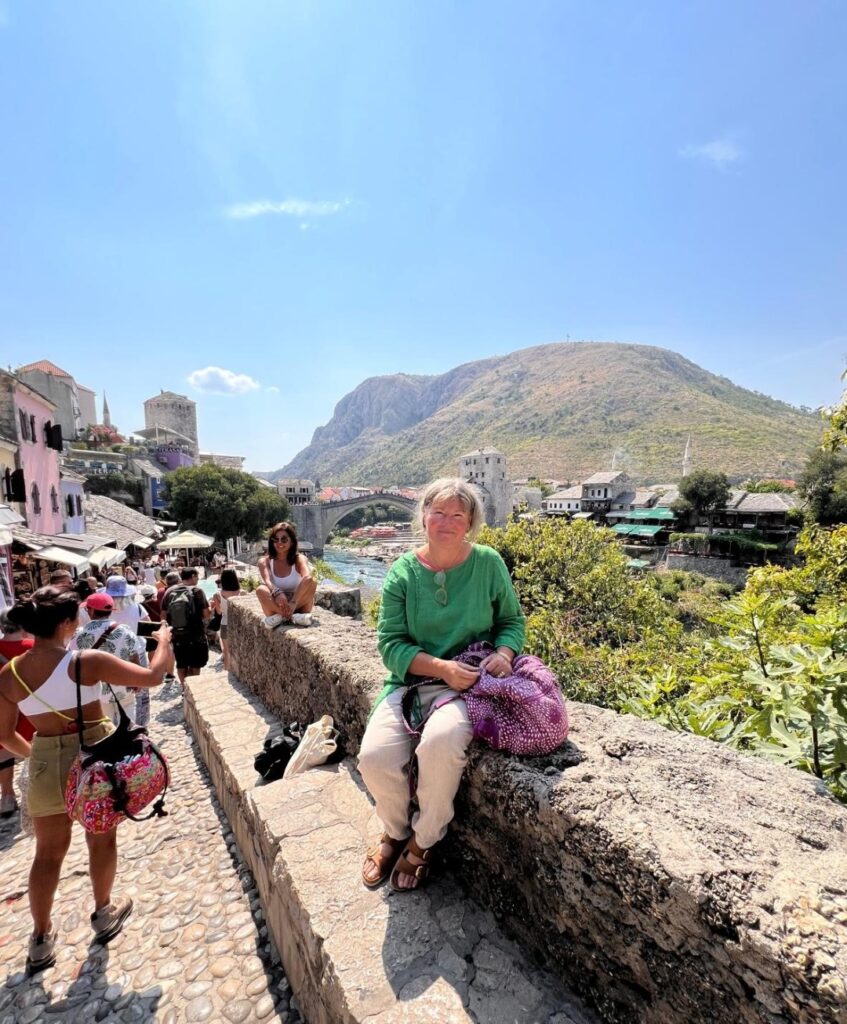
My first visit to Mostar in March 1996 was in an effort to unify the two customs administrations that existed there , one on each side of the river and collecting customs duties separately from Muslim and Croat importers . After visiting both Customs Directors my first role was to persuade both to meet at a neutral venue …not an easy task as the Muslim Director was just out of a year long imprisonment in the infamous Croatian Concentration Camp at Dretelli where his family didn’t know if he was alive or dead until a visiting Sky News team filmed a line of camp inmates and he held up a sign with his name on it … he was obviously reluctant to cross the river while the Croat Director on the West side of the river was adamantly definite no way was he going to cross the river to the Muslim side … as you can imagine this was not a scenario I had trained for in my previous life with the Irish Revenue Commissioners … we compromised on a meeting on the West Bank and I drove the Muslim Director across the river lying down on the back set of my Nissan Patrol covered in a blanket … not a good start but from their first meeting both officers got on really well and cooperated … and this was my experience throughout my ten years in Bosnia in that whatever side they were on and no matter what stance the nationalist politicians from all sides took , on a local level all were friendly to each other .
Did I see any differences now in Sarajevo and Mostar after eighteen years ?
You certainly see or at least I did an islamization of Sarajevo with women wearing the head scarfs and full burquas more prevalent now and maybe it was always there but under the surface in my time just after the Bosnian War but now you are certainly aware you are in a Muslim city which I am fine with but it must be disconcerting for Croat or Serb people .
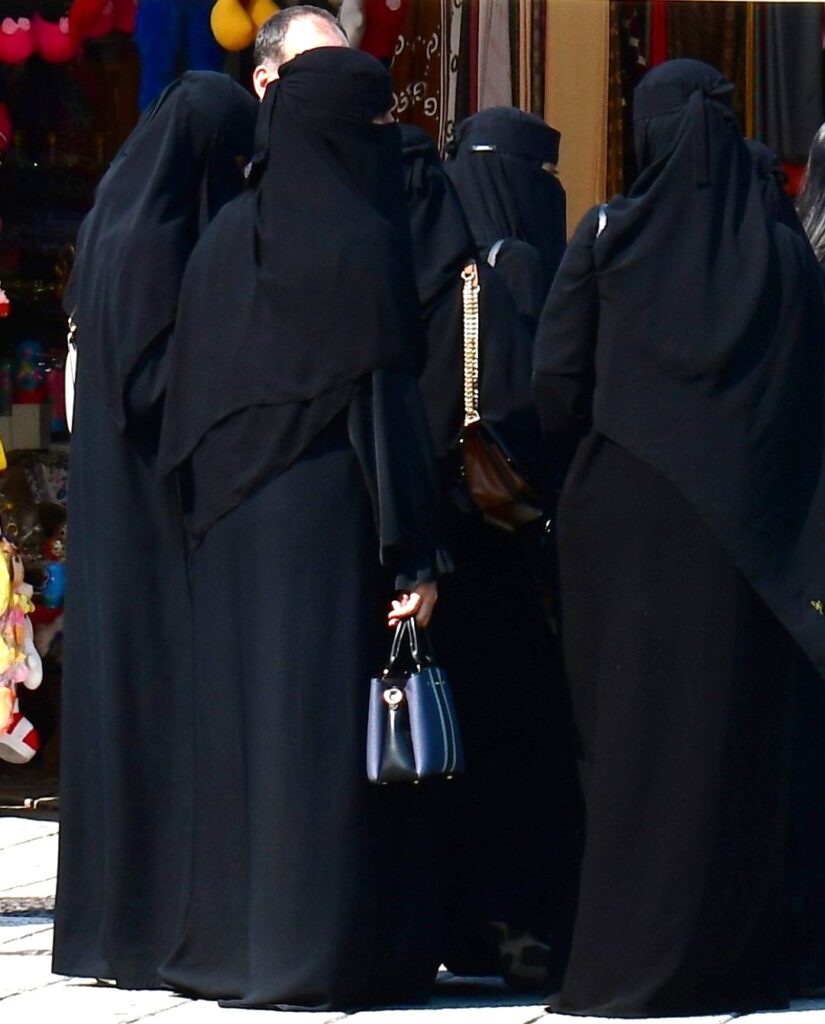
Shop owners we spoke to in Bacarsja say that most of the business ‘s in the Old City are now owned by Turkish business people from Istanbul … again no problem for me I like Turkish people but still it is a shame to see the Bosnian element and tradition being taken over .
But Sarajevo is Sarajevo , a magical place .
Mostar was always divided and especially after the war when I first visited and worked there you could see the bitterness and distrust between the Eastern Muslim side and the Western Croat side and that feeling is still there as the Old City is totally Muslim and proud of it while the Croats on the other bank of the Neretva ignore the Old Bridge area and go about their daily lives untouched by the tourism and commercialism and West Mostar has the air of a ghost town while he Muslim side is ramped up and buzzing with tourists all trying to get the perfect Tik Tok video !
I love Mostar though for it’s history , it’s defiance during the Bosnian War and just how it has bounced back after its near destruction in the early 1990’s .
The Stari Most of course gets all the crowds but a few hundred metres away on a small stream leading into the Neretva river is the bridge I love best in Mostar and one I always visit when in the city… the Kriva Cuorija Bridge built in 1558 known as the Crooked Bridge just down from the more famous Old Bridge … not much visited but always my favourite .
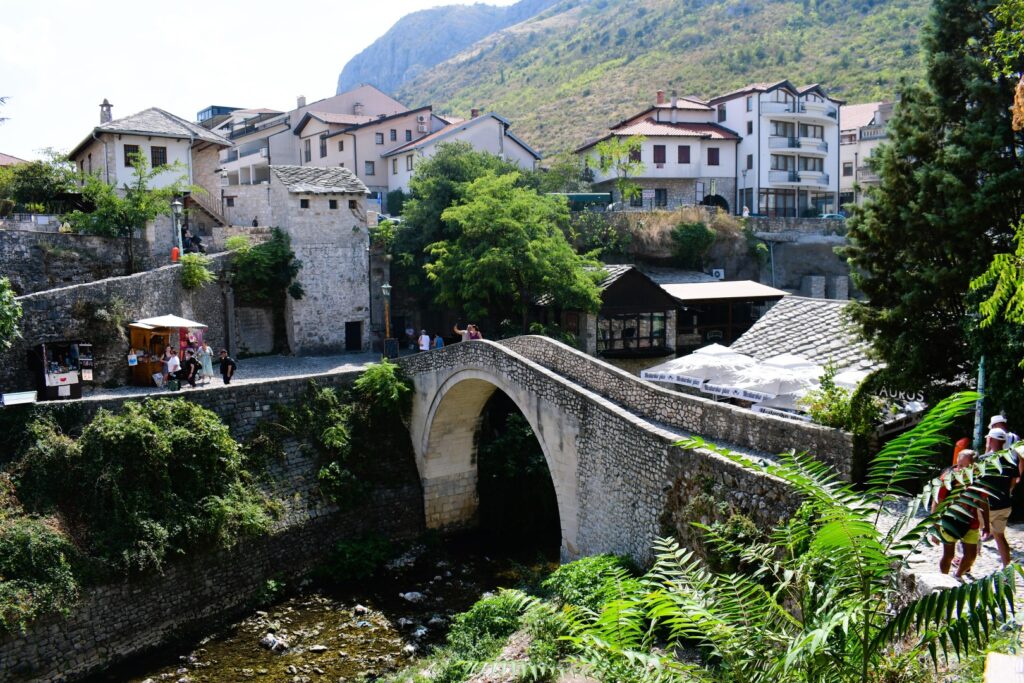
Mostar Memories from 1996 Bosnian Diary
Probably the most photographed and certainly the most famous of all is the bridge at Mostar over the Neretva river which now divides the Bosnian Muslim and Croat populations of the city who have bitter memories of each other from history and most recently the Bosnian War of 1993 and no intention anytime soon to start any reconciliation process .
The Mostar bridge , like all Ottoman bridges throughout the Balkans , is regarded by Croats and Serbs as a symbol of the hated “ Turkish ” occupation of the Balkans and even though it had protected UNESCO status this didn’t save it from being blown up by the Bosnian Croat army in 1993 who chillingly cheered as it fell into the river .
At the top of this photo of the Mostar Bridge you can see a giant Christian cross , 33 metres high , one for every year of Jesus’ life according to the architects but in reality designed not for piety but to be seen from the Muslim side of the Neretva river and coincidentally also marking the spot from where Bosnian Croat artillery destroyed the original bridge in 1993 … religions what ?
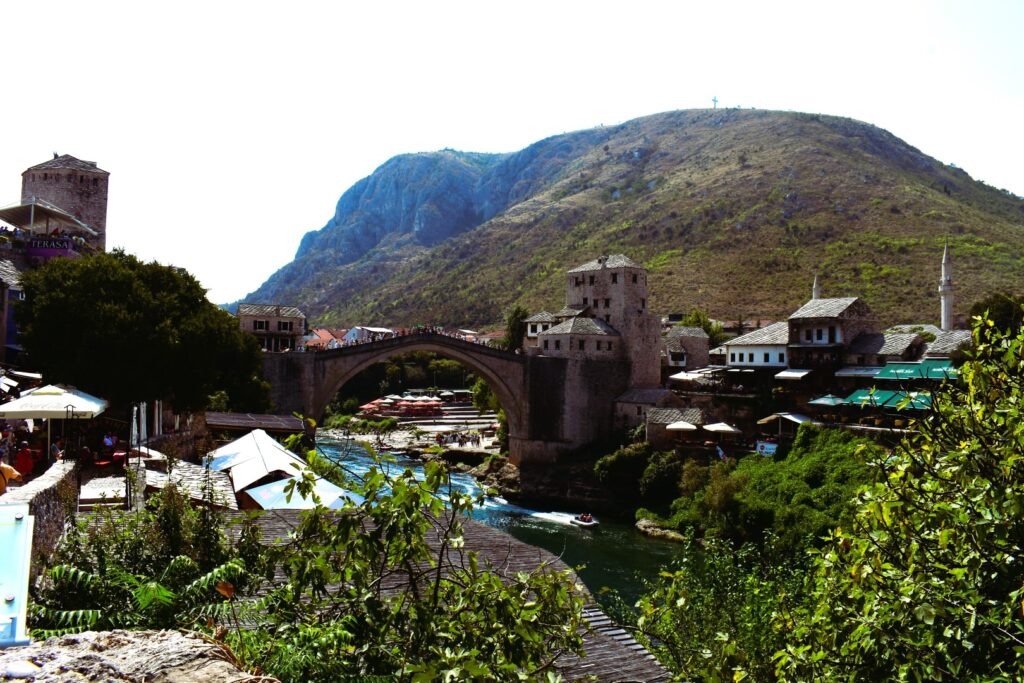
Local Balkan people I worked with were always surprised that I knew quite a bit about their history but as I explained my father , a life long member of the Irish communist party , made it mandatory for me to read from age eight onwards the weekly international communist party newspaper , Soviet Weekly … so I grew up learning data such as the yearly tractor production in Ukraine , wheat production in Serbia , copper mining in Macedonia and as for Tito …well I knew everything about Tito which as you can imagine went down a treat with my catholic priests and teachers in the 1950’s Ireland !!
Irish catholicism in the 1950’s was not a happy place for jews , protestants , muslims but top of the hate list with their own special place in hell were communists !
I used to walk across this bridge to my office every day for three years in Sarajevo and this was the bridge where a 19 year old student from NW Bosnia, Gavrillo Princip , assassinated Archduke Ferdinand on June 28th June 1914 , an event that sparked off World War 1 .
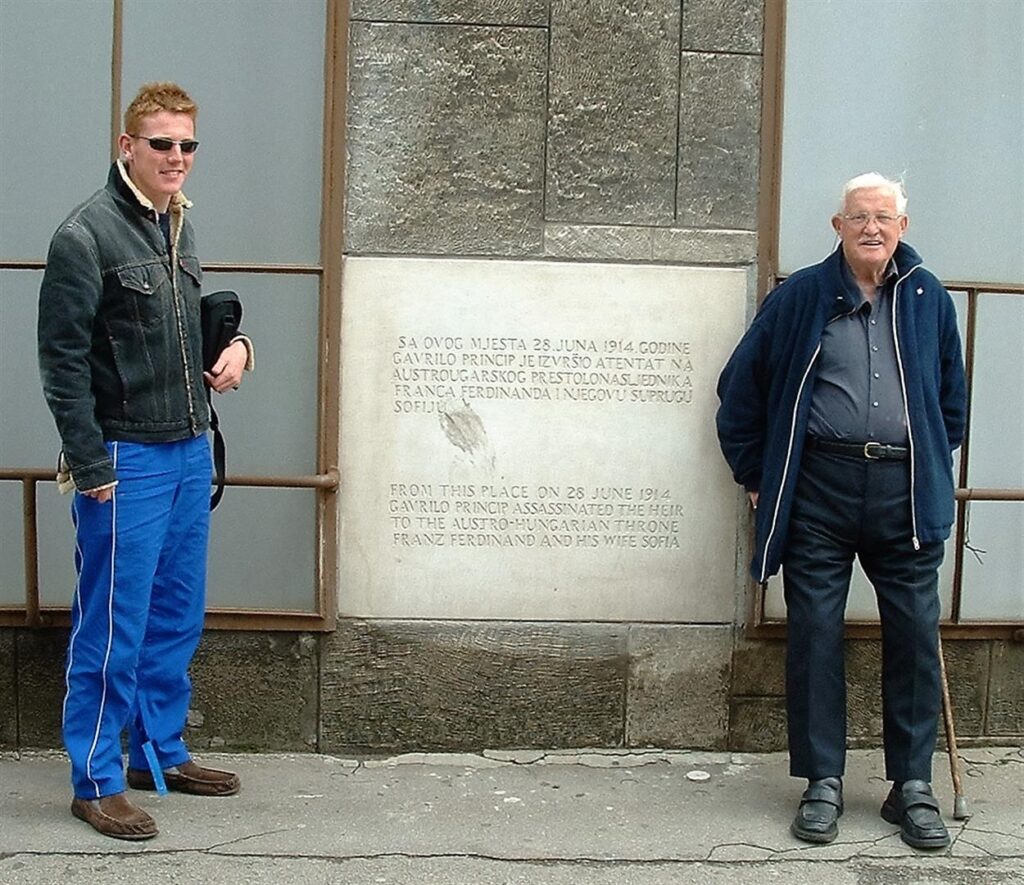
As a measure of how names change according to the political times , this bridge was built by the Ottomans in the 16th century and was known locally as the Latin Bridge as it crossed the river to where the catholic area of Sarajevo was , next after the annexation of Bosnia by Austria in 1908 it became known as the Austrian Bridge , this was changed in communist times in the 1950’s to ” Princip Bridge ” which is what it was still called when I first arrived in Sarajevo in 1996 however in the last few years it is known as ” The Freedom Bridge ” .
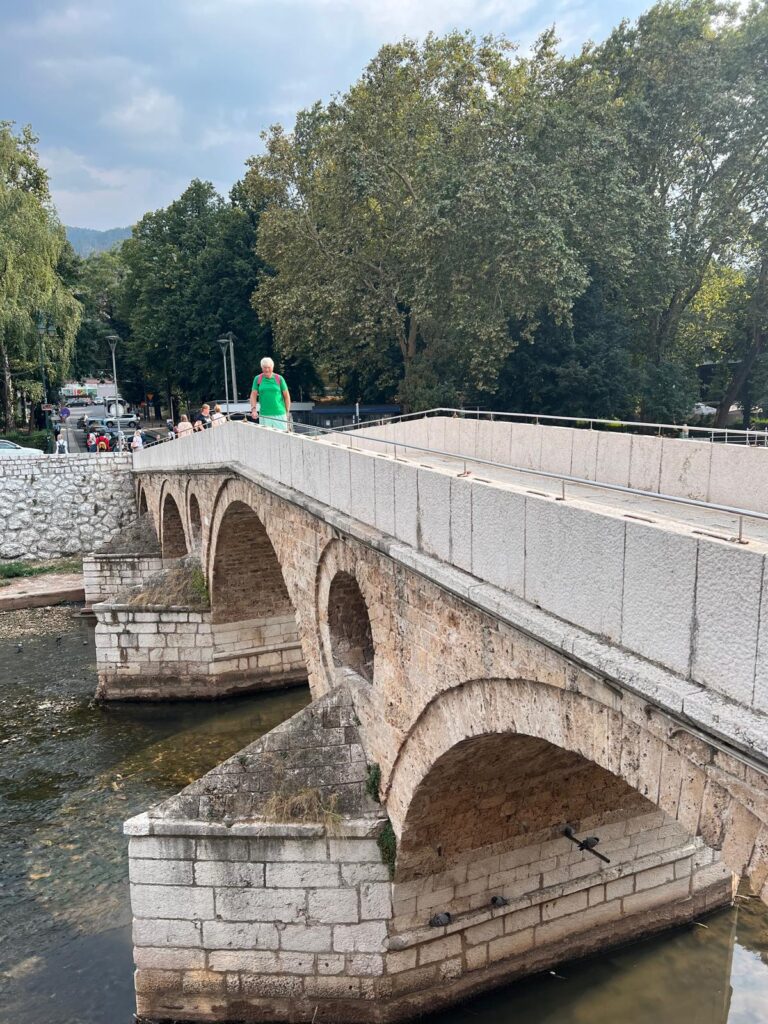
As a measure of how names change according to the political times , this bridge was built by the Ottomans in the 16th century and was known locally as the Latin Bridge as it crossed the river to where the catholic area of Sarajevo was , next after the annexation of Bosnia by Austria in 1908 it became known as the Austrian Bridge , this was changed in communist times in the 1950’s to ” Princip Bridge ” which is what it was still called when I first arrived in Sarajevo in 1996 however in the last few years it is known as ” The Freedom Bridge ” .
Bosnian Food
Anyway that is enough about history and suffering for one sitting and I‘ll end on a happy note … food … did I not mention that Balkan cuisine is the best in the world ?
Balkan food is basically Turkish cuisine with local variations and for me the most representative of Bosnian cuisine is burek closely followed by cevapcici and if you press me I ‘ll add stuffed peppers and the bean dish known as grah by the locals … these are the big four and I would happily exist on these for the rest of my life .
Burek is basically the chosen filling in a filo pastry roll and you choose from one (but never a mixture) of meat , potatoe , spinach or cheese and all of the ex Yugoslav countries , Slovenia , Croatia , Bosnia , Montenegro , Serbia , Macedonia , Kosovo, make it but of these you can forget Croatia and Slovenia as their heart was never in burek ( too Turkish for them so they have made pizza almost their national dish ) and they make a rubbish version … Montenegro , Serbia and Macedonia make a passable version of burek but too much dough for my liking and not enough mince … the best burek is made in Bosnia and the BEST burek in Bosnia is made in Sarajevo … this is not a subject for debate as just about the only thing Bosnian Croat , Muslim and Serb agree on is that the BEST burek is made in Sarajevo !
The first time I tasted burek was three days after I first set foot in the Balkans , on night duty in the Command Centre in Skopje of the MacSam Sanctions Mission , I was alone in the office at 2 am and a huge black US Customs Officer from Houston , Texas , came in and placed a greasy package in front of me … eat that he said and it will change your life … and it did !!
Cevapcici are small sausage size pockets of minced lamb served with raw chopped onions in a flat bread called lepinje with cold yogourt on the side and like burek everyone admits the BEST cevapcici are also made in Sarajevo in two shops owned by the same owner called Zeljo 1 and Zeljo 2 . This dish is the chicken and chips of the Balkans and outside of Sarajevo cevapcici are just a pale imitation so don’t go to Croatian areas such as Medugorje or Dubrovnik and order burek or cevapcici and think it is the real thing !
Grah or the Bean Dish is really only done well by the Serbs and in even the smallest of roadside shacks throughout Serbia and the Serb areas of Bosnia you will get through the winter on this dish alone … stuffed peppers can be done anywhere now all over Europe but the best , the very best stuffed peppers are done “ under the bell ” that is cooked in a covered iron pot on an open fire … in the Balkans but especially in coastal Croatia and throughout Bosnia .
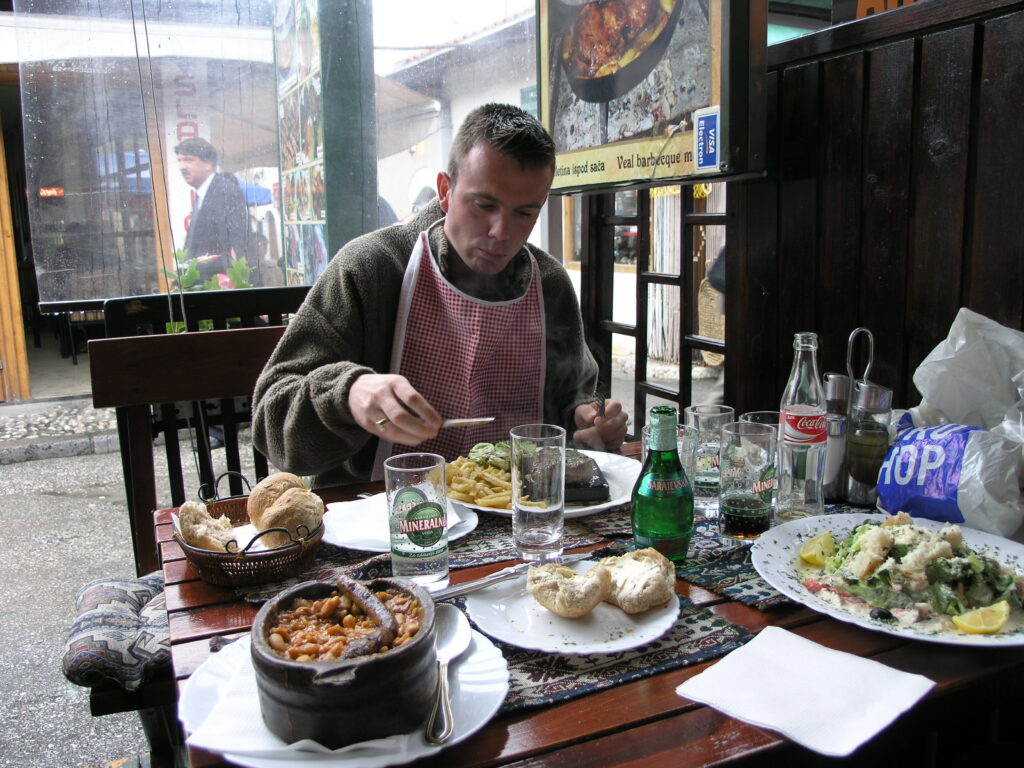
I can’t end without mentioning Ajvar which is a hot spicy paste made of roasted red peppers , garlic and onion preferably home made from Macedonian grown peppers and my first experience of it was in September 1994 in Skopje when it seemed every household was making their own ajvar in the garden in huge vats over open fires and the smell was everywhere .
Avjar is best made in Macedonia where the best red peppers in the Balkans are grown … again all the ex Yugoslav states made / make their own ajvar nowadays but all are just a pale imitation of the Macedonian one … Belgrade makes a passable version but don’t go near a Croatian or Slovenian ajvar .
.And if you want to read further about the Balkans
There have been hundreds of books written about the Bosnian War with most published in the five to six years immediately after the war ended in 1995 but to be honest most of these are not worth reading now as they are very biased and do not take into account the build up of tension under Tito when WW 2 ended nor how the memory of the atrocities committed against the Serbs by Croats and Muslims in that war festered and finally burst into ferocity at the break up of the Former Yugoslavia under Milosevic in 1991 .
The following are still in print and available through Amazon and are books I would recommend .
Misha Glenny is always reliable and his book The Fall of Yugoslavia is essential reading as is Laura Silber & Allan Little’s the Death of Yugoslavia which gives a factual account without bias on events leading up to the war in Yugoslavia . Noel Malcolm’s a Short History of Bosnia is excellent for background but is so dull it makes watching paint dry seem exciting . Richard Holbrooke’s To End a War is a great read if only to see the cynicism of the US in not allowing a Muslim / Croat total victory in 1995 as it didn’t suit US Foreign Policy to create a united Bosnia without separate entities . For sheer emotion plus great writing , Roger Cohen’s book Hearts grown Brutal , is a book I always enthuse about . If you want some specific overview I can recommend Tim Judah’s book the Serbs while Marcus Tanner’s book Croatia , a Nation forged in War is also good but Judah’s book is better and he has also written the classic book on Kosovo and the 1999 NATO campaign . Milos Stankovic’s book Trusted Mole is written from the perspective of a serving British army major whose father was a royalist Serb from Belgrade and is a great read .
Noel Malcolm’s book , A Short History of Bosnia , first published thirty years ago still on sale in Sarajevo 4th September 2024
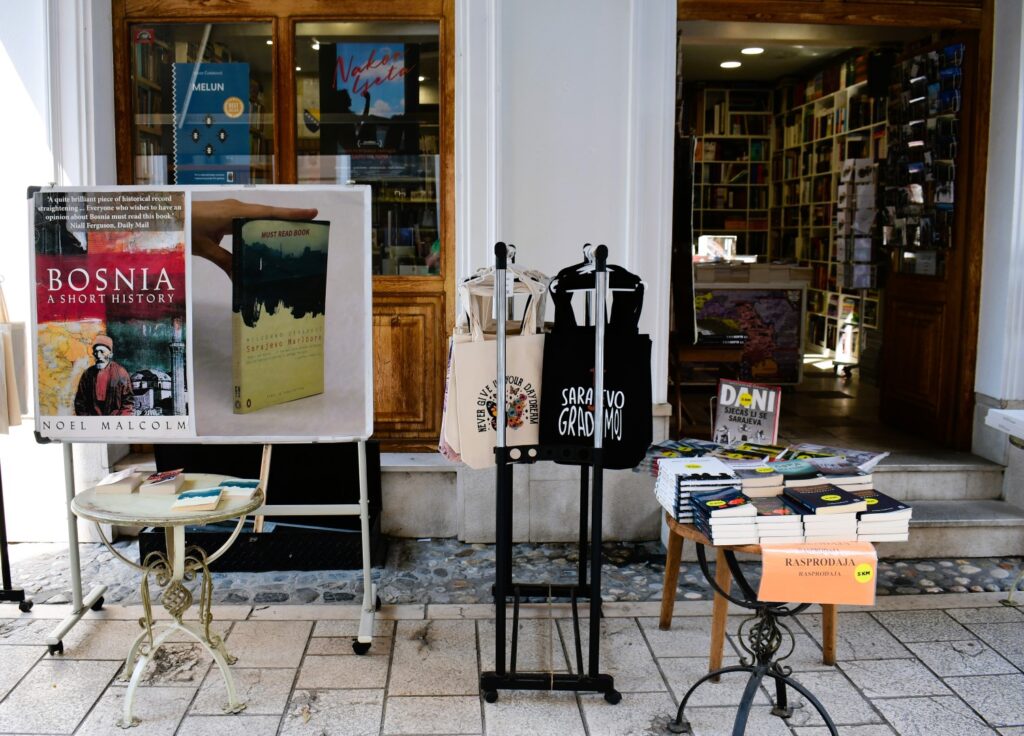
An unusual book is by our own Irish iconic writer , Dervla Murphy, who cycled at 71 through the Balkans from Zagreb to Albania in 1999 and wrote Through the Embers of Chaos and for me she has captured without bias the essence of the Balkans . I enjoyed reading Fighting for Peace by General Sir Michael Rose when it first came out in 1998 if only for the sheer pomposity and brio of the British General and I remember asking our team’s interpreter in Bihac what Rose was like as she had worked with him in 1994 for the few hours he helicoptered in to the Bihac enclave in NW Bosnia during the Serb siege and her brief summing up was brutally succint ” Tall , extremely good looking and totally out of touch with reality ” … boom boom !!
One off autobiographical books about their time in Bosnia that I found interesting would be Balkan Odyssey by David Owens , Blood and vengeance by Chuck Sudetic , Peace Journey by Carl Bildt , Angela Clark wrote an interesting book about Orthodoxy called When Angels Fall and the really unusual almost surreal book by Anthony Loyd called My war is ended I miss it so and both these books are great reads. When I first arrived to work in the Former Yugoslavia in May 1994 the book everyone and particularly the US members of the Macedonian Mission raved about as the ideal background introduction was Balkan Ghosts by Robert Kaplan which is still very popular but I always found it useless .
Every essential reading list will include Black Lamb and Grey Falcon by Rebecca West , almost 1200 pages , written in the 1930’s , the book is worth picking up second hand and dipping in to now and again but it is the War & Peace of the Balkans for showing off on the book shelf or under your arm in the cafe … but never read !
Lastly I would mention a book published in 2014 to mark the 100 year anniversary of the start of World War 1 written by Tim Butcher called The Trigger in which he traces the story of Gavrillo Princip from a peasant background in Western Bosnia to that fateful day in Sarajevo on June 28th 1914 aged 19 when he pulled the trigger that changed the course of world history . The book is fascinating and reads like a novel and I would suggest you start with this book and if his travel on foot through Bosnia and Serbia hook you then take your pick from any of the other books I have listed .
Pots in the Garden
We should always remember our garden pots are actually our prisoners who depend on us for food , water , right position and without those elements in place the plants will not thrive apart from extreme rock plants such as semper vivum or aquave which actually thrive on neglect …. I have found that box balls can manage drought if positioned in semi shade .

Last word on the revamp of the Front Garden
Our neighbour , Michelle Boisson , took this photo through the front gate two days ago while we were away … beautiful composition and the fading colours of the parrotia tree sums up the coming autumnal season perfectly .



Leave a Reply